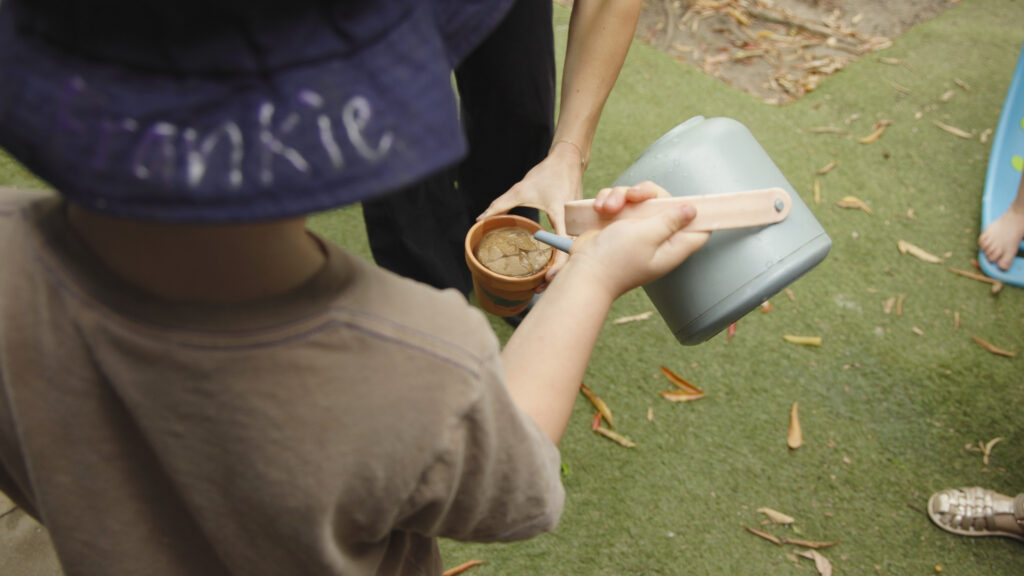
Children arrive with unique personalities, strengths, needs, and ways of communicating. Some transition seamlessly into a new environment, while others take more time to adjust to the rhythm of childcare. All of this is completely normal — and completely human.
Every family wants to know one thing: Will my child feel safe, understood, and supported when I’m not there?
At Sanctuary, we hold that question gently in everything we do.
Supporting children through behavioural challenges is not about correcting behaviour; it’s about understanding the story behind it. It’s about nurturing confidence, strengthening emotional wellbeing, and creating a sense of belonging where every child feels safe to be themselves.
Understanding Behavioural Challenges in Childcare
Young children communicate primarily through behaviour. Whether they’re feeling overwhelmed, curious, tired, unsure, excited, or needing connection, their behaviour often tells us what their words cannot.
Common behavioural expressions we see in early learning may include:
- Tantrums and emotional outbursts
- Physical responses such as hitting or biting
- Social withdrawal or hesitation to join group activities
- Resistance to instructions or transitions
- Separation anxiety or clinginess
- Difficulty sharing or taking turns
- Sensory-seeking or sensory-avoidant behaviours
Each of these behaviours is a clue. And when we approach these clues with curiosity and compassion, we learn how to support each child more effectively.
Why Behavioural Challenges Arise
Understanding the root causes behind challenging behaviours helps us respond thoughtfully rather than reactively. Some common triggers include:
- Adjustment to new routines and expectations
- Difficulty expressing emotions verbally
- Overstimulation or understimulation in busy environments
- Separation from primary caregivers
- Developmental stages such as asserting independence
- Underlying needs such as hunger, tiredness, or physical discomfort
- Sensory processing differences (sensitivity to noise, light, texture, or movement)
- Neurodevelopmental differences (autism, ADHD, or other variations)
- Previous experiences that affect feelings of safety and trust.
Children aren’t misbehaving intentionally—their behaviour reflects their emotional needs, developmental stage, and unique way of experiencing the world at that moment.
At Sanctuary, we look beyond the behaviour to understand why it’s occurring. This helps us respond in ways that build trust, emotional security, and a strong sense of connection.
How Sanctuary Educators Support Positive Behaviour
Our educators play a pivotal role in helping children regulate emotions, build social skills, and navigate early friendships. Guided by Sanctuary’s values and our Family Model of Support, our teams work closely with each child and where necessary, families to:
- Build secure, trusting relationships
- Provide predictable routines that help children feel safe
- Use gentle, strengths-based guidance
- Model calm, respectful behaviour
- Support emotional regulation with tailored strategies
- Honour sensory differences and diverse learning styles
- Ensure every child feels seen, valued, and included.
Rather than focusing on compliance, we focus on teaching children better ways to express feelings, meet needs, and develop social-emotional competence.
Strategies Educators Use to Support Behaviour
Behavioural challenges need consistent, compassionate strategies that guide children towards positive outcomes.
Clear, Consistent Expectations
Children feel more confident when the environment is predictable.
Simple phrases like “We use gentle hands” or “We listen to each other” help children understand what is expected. Visual schedules and social stories also support understanding of routines and expectations.
Positive Reinforcement & Descriptive Praise
Rather than focusing on what children shouldn’t do, educators notice and encourage desired behaviours. Specific, descriptive praise helps children understand exactly what they did well. Examples include:
- Descriptive praise (“I noticed how you waited patiently for your turn. That showed great self-control!”)
- Recognition of effort and progress, not just outcomes
- Natural consequences that help children see the positive impact of their actions.
This approach builds children’s self-esteem and intrinsic motivation, helping them understand the value of positive behaviours rather than performing only for external rewards.
Modelling Calm Responses
Children learn by observing adults. When an educator responds calmly to a child’s distress, it demonstrates emotional regulation. Over time, children internalise these models and learn to manage their own feelings more effectively.
Maintaining a calm, patient demeanor also prevents escalation and maintains a sense of safety within the environment.
Redirection and offering choices
Sometimes, simply shifting a child’s focus can prevent behaviour from escalating. If a child is becoming frustrated with a puzzle, an educator might redirect them to a different activity or offer choices, allowing them to reset emotionally without confrontation.
Offering appropriate choices (“Would you like to use the blocks or do some painting?”) gives children a sense of agency and control while maintaining necessary boundaries.
Supporting emtotional literacy
Many behavioural challenges arise because young children are still developing the ability to express feelings verbally. Helping children learn emotional vocabulary like “angry,” “frustrated,” “overwhelmed,” or “sad” empowers them to communicate needs more effectively.
Educators may use:
- Storybooks and picture books about emotions
- Songs and movement activities
- Emotion cards or visual aids
- Role-play and puppet play
- “Feelings check-ins” during the day
Children also benefit from learning that all feelings are valid, even when certain behaviours are not acceptable.
Creating calming and sensory spaces
Having designated calming spaces within the centre gives children opportunities to self-regulate. Soft furnishings, sensory tools (fidgets, weighted items, textured objects), dimmed lighting, and soothing visuals create safe places where children can retreat when they feel overwhelmed.
Important: The calming space should always be:
- A voluntary choice for the child, never forced isolation
- Presented as a positive tool for self-care and emotional reset
- Accessible when children need it, not used punitively
- Designed with input from children when possible
Supporting sensory needs
Every child processes sensory information differently. Some children are highly sensitive to sounds, lights, or textures, while others seek intense sensory input. Quality childcare environments:
- Provide quiet spaces and active spaces
- Offer sensory materials (playdough, sand, water, textured objects)
- Allow for movement breaks and alternative seating
- Adjust lighting and noise levels when possible
- Recognise that sensory needs are real and valid
Understanding sensory needs prevents many behavioural challenges before they occur.
Supporting peer relationships and conflict resolution
Helping children develop social skills and navigate conflicts with peers is essential. Educators can:
- Facilitate peer problem-solving with guidance
- Teach specific friendship skills (sharing, turn-taking, asking to join play)
- Support children in understanding different perspectives
- Use restorative practices to repair relationships after conflicts
- Celebrate diverse friendship styles (some children prefer one close friend; others enjoy larger groups)
Supporting neurodivergent and neurotypical behavioural expressions
As part of Sanctuary’s Family Model of Support, we recognise that children experience the world differently — whether they are neurodivergent, neurotypical, sensory-seeking, sensory-sensitive, or simply navigating big feelings.
Under this model, we:
- Partner closely with families to understand each child’s strengths, needs, and communication style
- Tailor strategies to the individual child
- Honour diverse ways of processing information
- Collaborate with allied health professionals when families choose
- Adapt environments and routines to support regulation
- Focus on connection, belonging, and emotional safety above all
We do not see behaviour as a “problem to be fixed,” but as communication that deserves understanding, respect, and a relational response. Children experiencing neurodivergent or neurotypical behavioural expressions are supported with equal dignity, inclusivity, and intentionality.
The Importance of partnership Between families & Educators
Children thrive when families and educators work together. Our approach includes:
- Warm, regular, respectful communication about a child’s progress, strengths and needs
- Shared strategies that align home and centre expectations
- Acknowledgement of families as experts on their child
- Collaborative planning for additional support when needed
- Respect for cultural values and family preferences
Relationships with families sit at the heart of how Sanctuary creates safe spaces for children to grow.
When Additional Support May Be Needed
Most behavioural expressions are a natural part of development. However, if a child needs extra support, we partner with families to explore options such as occupational therapy, speech pathology, psychology, or early intervention services. Seeking support shows responsive, proactive caregiving — never failure.
Important: Seeking support is a sign of responsive caregiving, not failure. Early support leads to better outcomes and helps children develop the skills they need to thrive.
Creating Behaviour-Supportive Environments at Sanctuary
Our centres are intentionally designed with each child’s regulation, learning, and wellbeing in mind. This includes:
- Thoughtful environments that consider sensory needs
- Personalised support where appropriate
- Programs that prioritise social-emotional learning
- Educators trained in trauma-informed, neuroaffirming, and inclusive practice
- Daily rhythms that balance structure and freedom
- Celebration of diversity in all its forms
- Continued reflection on how our practices serve each child.
We see behaviour guidance as an invitation to understand the child more deeply — and to create environments where all children feel safe, calm, and connected.
Looking for Childcare Near You? Call Us Today
Every behaviour tells a story. When we respond with empathy, curiosity, and connection, we help children learn who they are and how they belong in the world.
At Sanctuary, we believe there is no “one way” to be a child.
There are only unique individuals who deserve support, understanding, and a safe space to grow.
And that is exactly what we are here to provide — every moment, every day.
If you want to know about how our child care centres support all families and children through behavioural challenges, model inclusion and nurture belonging, visit our Locations page to find a centre near you.



